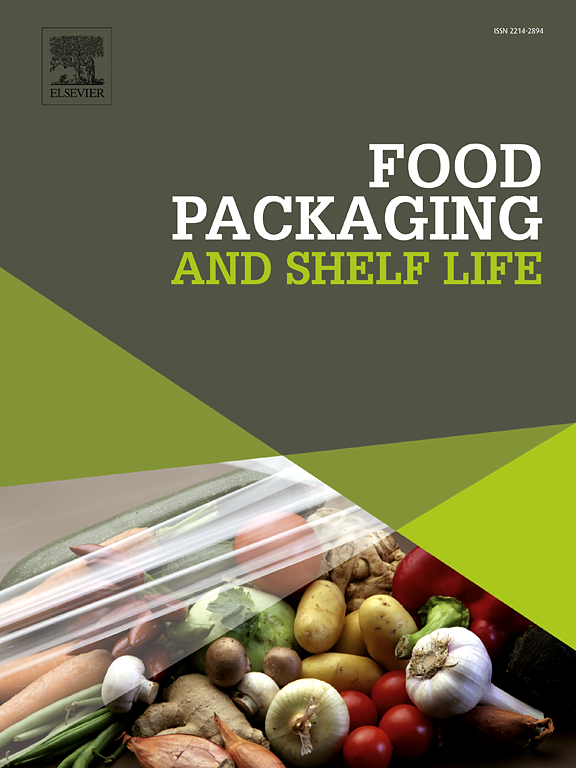Novel dual-crosslinked antimicrobial hydrogels of oxidized hyaluronic acid/gelatin grafted with curcumin-Zn2+ complexes for preservation of chilled chicken
IF 8.5
1区 农林科学
Q1 FOOD SCIENCE & TECHNOLOGY
引用次数: 0
Abstract
To enhance the solubility and stability of curcumin, a novel double-crosslinked antimicrobial hydrogels OHA/GEL/CUR-Zn(II) was prepared. Curcumin, as a ligand, was complexed with Zn2+ to form a stable complex (CUR-Zn(II)), which was grafted to the hydrogel formed by oxidized hyaluronic acid (OHA) and gelatin (GEL) through Schiff base reaction. Fourier transform infrared spectroscopy analysis was employed to determine the formation of Schiff base (C![]() N) between OHA with GEL, as well as the ester bond between OHA with CUR-Zn(II). X-ray diffraction results showed the presence of amorphous peaks in the composite film. The change in crystal structure was probably due to the formation of new hydrogen bonding or chemical bonding between CUR-Zn(II) and OHA/GEL. The incorporation of CUR-Zn(II) complexes into a hydrogel matrix resulted in a significant enhancement of tensile strength (TS) and elongation at break, accompanied by a reduction in water vapor transmission rate. Meanwhile, the hydrogel achieved a bactericidal rate of over 99 % against the predominant spoilage bacteria Escherichia coli and Staphylococcus aureus in chilled chicken meat, extending the shelf life of the chilled chicken meat to over 8 days. Overall, the composite hydrogel enhanced the stability of curcumin by chelating it with Zn2+ and increased its solubility by grafting it onto OHA and GEL cross-linked hydrogels, demonstrating significant application potential in food packaging.
N) between OHA with GEL, as well as the ester bond between OHA with CUR-Zn(II). X-ray diffraction results showed the presence of amorphous peaks in the composite film. The change in crystal structure was probably due to the formation of new hydrogen bonding or chemical bonding between CUR-Zn(II) and OHA/GEL. The incorporation of CUR-Zn(II) complexes into a hydrogel matrix resulted in a significant enhancement of tensile strength (TS) and elongation at break, accompanied by a reduction in water vapor transmission rate. Meanwhile, the hydrogel achieved a bactericidal rate of over 99 % against the predominant spoilage bacteria Escherichia coli and Staphylococcus aureus in chilled chicken meat, extending the shelf life of the chilled chicken meat to over 8 days. Overall, the composite hydrogel enhanced the stability of curcumin by chelating it with Zn2+ and increased its solubility by grafting it onto OHA and GEL cross-linked hydrogels, demonstrating significant application potential in food packaging.
姜黄素- zn2 +络合物接枝氧化透明质酸/明胶的新型双交联抗菌水凝胶用于冷藏鸡肉的保存
为了提高姜黄素的溶解度和稳定性,制备了一种新型双交联抗菌水凝胶OHA/GEL/CUR-Zn(II)。以姜黄素为配体,与Zn2+络合形成稳定的络合物(CUR-Zn(II)),通过希夫碱反应接枝到氧化透明质酸(OHA)与明胶(GEL)形成的水凝胶上。利用傅里叶变换红外光谱分析确定了OHA与GEL之间的席夫碱(CN)的形成,以及OHA与cu - zn (II)之间的酯键。x射线衍射结果表明复合膜中存在非晶态峰。晶体结构的变化可能是由于cu - zn (II)与OHA/GEL之间形成了新的氢键或化学键。将cu - zn (II)配合物掺入水凝胶基质中,可显著提高材料的抗拉强度(TS)和断裂伸长率,同时降低水蒸气透过率。同时,水凝胶对冷鲜鸡肉中主要腐败菌大肠杆菌和金黄色葡萄球菌的杀菌率达到99% %以上,使冷鲜鸡肉的保质期延长至8天以上。综上所述,复合水凝胶通过与Zn2+螯合增强了姜黄素的稳定性,并通过接枝到OHA和GEL交联水凝胶上提高了姜黄素的溶解度,在食品包装方面具有重要的应用潜力。
本文章由计算机程序翻译,如有差异,请以英文原文为准。
求助全文
约1分钟内获得全文
求助全文
来源期刊

Food Packaging and Shelf Life
Agricultural and Biological Sciences-Food Science
CiteScore
14.00
自引率
8.80%
发文量
214
审稿时长
70 days
期刊介绍:
Food packaging is crucial for preserving food integrity throughout the distribution chain. It safeguards against contamination by physical, chemical, and biological agents, ensuring the safety and quality of processed foods. The evolution of novel food packaging, including modified atmosphere and active packaging, has extended shelf life, enhancing convenience for consumers. Shelf life, the duration a perishable item remains suitable for sale, use, or consumption, is intricately linked with food packaging, emphasizing its role in maintaining product quality and safety.
 求助内容:
求助内容: 应助结果提醒方式:
应助结果提醒方式:


